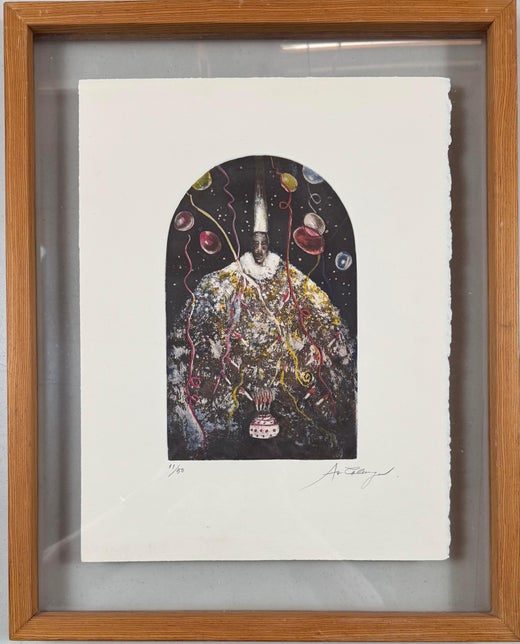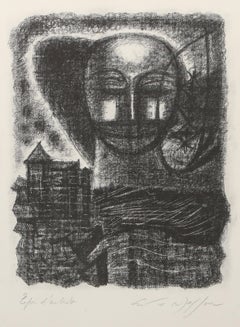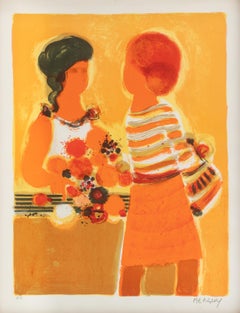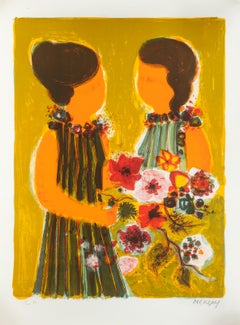Want more images or videos?
Request additional images or videos from the seller
1 of 5
Alejandro ColungaClown on Tricycle
$1,400List Price
About the Item
- Creator:Alejandro Colunga (1948, Mexican)
- Dimensions:Height: 34.5 in (87.63 cm)Width: 25 in (63.5 cm)
- Medium:
- Movement & Style:
- Period:
- Condition:
- Gallery Location:Long Island City, NY
- Reference Number:1stDibs: LU4661340873
Alejandro Colunga
Alejandro Colunga Marín (b. December 11, 1948, Guadalajara, Jalisco) is a self-taught Mexican artist celebrated for his vivid, fantastical prints, paintings and sculptures. He was initially trained aas an architect and also studied music and anthropology—but chose to pursue art independently, drawing on folklore, surrealist traditions, and immersive life experiences Over a career spanning five decades, Colunga has exhibited across the Americas and Europe since 1968. His pieces are acquired by major institutions like the Museo Amparo (Puebla), San Antonio Museum of Art, Nassau County Museum of Art, and publicly installed in Guadalajara and Puerto Vallarta. Recognized with awards such as the Minerva a las Artes (1988), Jalisco a las Artes (1994), and an architecture prize for “La Sala de los Magos,” his work continues to be a beloved synthesis of Mexican cultural identity, theatricality, and magical realism . His art remains an enduring celebration of imagination, inviting audiences into a surreal world where art, function, folklore, and fantasy collide.
About the Seller
4.9
Platinum Seller
Premium sellers with a 4.7+ rating and 24-hour response times
Established in 1979
1stDibs seller since 2014
3,166 sales on 1stDibs
Typical response time: 1 hour
Authenticity Guarantee
In the unlikely event there’s an issue with an item’s authenticity, contact us within 1 year for a full refund. DetailsMoney-Back Guarantee
If your item is not as described, is damaged in transit, or does not arrive, contact us within 7 days for a full refund. Details24-Hour Cancellation
You have a 24-hour grace period in which to reconsider your purchase, with no questions asked.Vetted Professional Sellers
Our world-class sellers must adhere to strict standards for service and quality, maintaining the integrity of our listings.Price-Match Guarantee
If you find that a seller listed the same item for a lower price elsewhere, we’ll match it.Trusted Global Delivery
Our best-in-class carrier network provides specialized shipping options worldwide, including custom delivery.You May Also Like
The Song of Songs - Nice French Russian Song of Songs
By (after) Marc Chagall
Located in London, GB
This lithograph is hand signed in pencil by the artist "Marc Chagall" at the lower right corner.
It is also hand numbered in pencil 47 from the edition of 200, at the lower left mar...
Category
1970s Surrealist Figurative Prints
Materials
Lithograph
$37,000
H 27.96 in W 21.07 in
Children - Lithograph by Giuseppe Migneco - mid-20th Century
Located in Roma, IT
Children is a modern artwork realized by Giuseppe Migneco in the mid-20th Century.
Mixed colored lithograph.
Hand signed and numbered on the lower margin
Edition 60/150
Includes ...
Category
Mid-20th Century Surrealist Figurative Prints
Materials
Lithograph
$237
H 24.81 in W 18.12 in D 0.79 in
Le Bouquet Rose
By Marc Chagall
Located in London, GB
Lithograph in colours, 1980, on Arches paper, signed in pencil, numbered from the edition of 50, published by Maeght Editeur, Paris, image: 94 x 69.9 cm. (37 x 23 ½ in.), sheet: 116....
Category
1980s Surrealist Figurative Prints
Materials
Lithograph
Les Amoureux à l'Isba
By Marc Chagall
Located in London, GB
Lithograph in colours, 1980, on Arches paper, signed in pencil, numbered from the edition of 50, published by Maeght Editeur, Paris, image: 60 x 94.3 cm. (23 5/8 x 37 1/8 in.), sheet...
Category
1980s Surrealist Figurative Prints
Materials
Lithograph
Les Clowns Musiciens
By Marc Chagall
Located in London, GB
Lithograph in colours, 1980, on Arches paper, signed in pencil, numbered from the edition of 50, published by Maeght Editeur, Paris, image: 95.3 x 60.4 cm. (37 ½ x 23 ¾ in.), sheet: ...
Category
1980s Surrealist Figurative Prints
Materials
Lithograph
La Parade
By Marc Chagall
Located in London, GB
Lithograph in colours, 1980, on Arches paper, signed in pencil, numbered from the edition of 50, published by Maeght Editeur, Paris, image: 95.9 x 61.6 cm. (37 ¾ x 24 ¼ in.), sheet: ...
Category
1980s Surrealist Figurative Prints
Materials
Lithograph
Les Lilas
By Marc Chagall
Located in London, GB
Lithograph in colours, 1980, on Arches paper, signed in pencil, numbered from the edition of 50, published by Maeght Editeur, Paris, image: 92.1 x 60.3 cm. (36 ¼ x 23 ¾ in.), sheet: ...
Category
1980s Surrealist Figurative Prints
Materials
Lithograph
Dans le Ciel de l’Opera
By Marc Chagall
Located in London, GB
Lithograph in colours, 1980, on Arches paper, signed in pencil, numbered from the edition of 50, published by Maeght Editeur, Paris; image: 95.3 x 61 cm. (37 ½ x 24 in.); sheet: 116....
Category
1980s Surrealist Figurative Prints
Materials
Lithograph
Jean COCTEAU and Raymond MORETTI : The Evolution - Original Hansigned Lithograph
By Jean Cocteau
Located in Paris, IDF
Jean Cocteau and Raymond Moretti
Earth's Evolution
Original lithograph
Printed signature in the plate, handsigned by Raymond Moretti
Numbered 1/79
On Arches vellum 50 x 65 cm (c. 1...
Category
1970s Surrealist Figurative Prints
Materials
Lithograph
Tightrope and Fiddle
By Charles Cobelle
Located in San Francisco, CA
This artwork titled "Tightrope and Fiddle" c.1975, is an original colors lithograph on Wove paper by noted French/American artist Charles Cobelle, 1902-1994. It is hand signed and numbered 117/500 in pencil by the artist. The artwork (image) size is 34.5 x 22.25 inches, framed size is 43.25 x 30.5 inches. Custom framed in a gold ornate frame, with off-white matting. It is in excellent condition.
About the artist:
Charles Cobelle, born Carl Edelman (1902–1994), was a modern French master of painting, lithography and a fine muralist, who was born in Alsace-Lorraine, France. He is considered the last link to the great tradition of the Open Line School of Paris.
Biography
Cobelle received his bachelor's and master's degrees from the University of Munich and continued his studies at the École des Beaux-Arts in Paris. Much more influential in his development, however, were his private studies with Marc Chagall and his apprenticeship in the studio of Raoul Dufy in Menton on the Riviera.
Cobelle lived and painted in Paris until the late 1920s and established himself within the great tradition of the School of Paris.[2] In the late 1920s, Cobelle moved to the United States, where his paintings were immediately sought after by galleries and private collectors alike. Cobelle became a U.S. citizen before the outbreak of World War II. In the late 1940s to 1950s, Cobelle lived in Westport, Connecticut.Charles Cobelle lived in Ridgefield CT in a private lake community called Twixt Hills until his death.
By the 1950s, spurred by the commercial success of his mentor, Dufy, Cobelle had achieved phenomenal success commercially with his Parisian-influenced style. Much like contemporary artists and designers at the time, his designs graced a number of pottery patterns for various pottery companies, including Midwinter Stylecraft, Universal Potteries and Homer Laughlin China...
Category
Late 20th Century Surrealist Nude Prints
Materials
Lithograph
More From This Seller
View AllApparition, Surrealist Lithograph by André Masson
By André Masson
Located in Long Island City, NY
André Masson, French (1896 -1987) - Apparition pour les poèmes de Emily Brontë, Year: circa 1945, Medium: Lithograph on thin wove paper, signed and numbered in pencil, Edition: AP...
Category
1940s Surrealist Figurative Prints
Materials
Lithograph
Les Bijoux Indiscrets, Surrealist Lithograph after Rene Magritte
By (after) René Magritte
Located in Long Island City, NY
Artist: Rene Magritte
Title: Les Bijoux Indiscrets (The Indiscrete Jewels)
Year of Original: 1963
Year of Printing: 1975
Medium: Lithograph, signed in the plate
Edition Size: 575
I...
Category
1960s Surrealist Figurative Prints
Materials
Lithograph
La Fleuriste, Surrealist Lithograph by Frederic Menguy
By Frederic Menguy
Located in Long Island City, NY
Frederic Menguy, French (1927 - 2007) - La Fleuriste, Year: circa 1970, Medium: Lithograph, signed and numbered in pencil, Edition: 95/200, Size: 20.75 x 15.75 in. (52.71 x 40.01...
Category
1970s Surrealist Figurative Prints
Materials
Lithograph
Femmes aux Fleurs, Surrealist Lithograph by Frederic Menguy
By Frederic Menguy
Located in Long Island City, NY
Frederic Menguy, French (1927 - 2007) - Femmes aux Fleurs, Year: 1970, Medium: Lithograph, signed and numbered in pencil, Edition: EA, Size: 20.75 x 15.75 in. (52.71 x 40.01 cm)
Category
1970s Surrealist Figurative Prints
Materials
Lithograph
Detente, Surrealist Lithograph by Frederic Menguy
By Frederic Menguy
Located in Long Island City, NY
Frederic Menguy, French (1927 - 2007) - Detente, Year: 1975, Medium: Lithograph, signed in pencil, Edition: EA, Size: 15 x 22.5 in. (38.1 x 57.15 cm)
Category
1970s Surrealist Figurative Prints
Materials
Lithograph
The Letter, Surrealist Lithograph by Romas Viesulas
Located in Long Island City, NY
Romas Viesulas (1918 - 1986) - The Letter, Year: 1954, Medium: Lithograph on Basingwerk Parchment paper, signed and numbered in pencil, Image Size: 10.25 x 14.5 inches, Size: 13 ...
Category
1950s Surrealist Figurative Prints
Materials
Lithograph
Recently Viewed
View AllRead More
Romare Bearden’s Humanity Infuses His Bright, Bold Art
Through collage, painting and printmaking, the artist foregrounded Black life in America in revolutionary new ways.
Chryssa’s 1962 Neon Sculpture Was Way ahead of the Art-World Curve
By working with lettering, neon and Pop imagery, Chryssa pioneered several postmodern themes at a time when most male artists detested commercial mediums.



